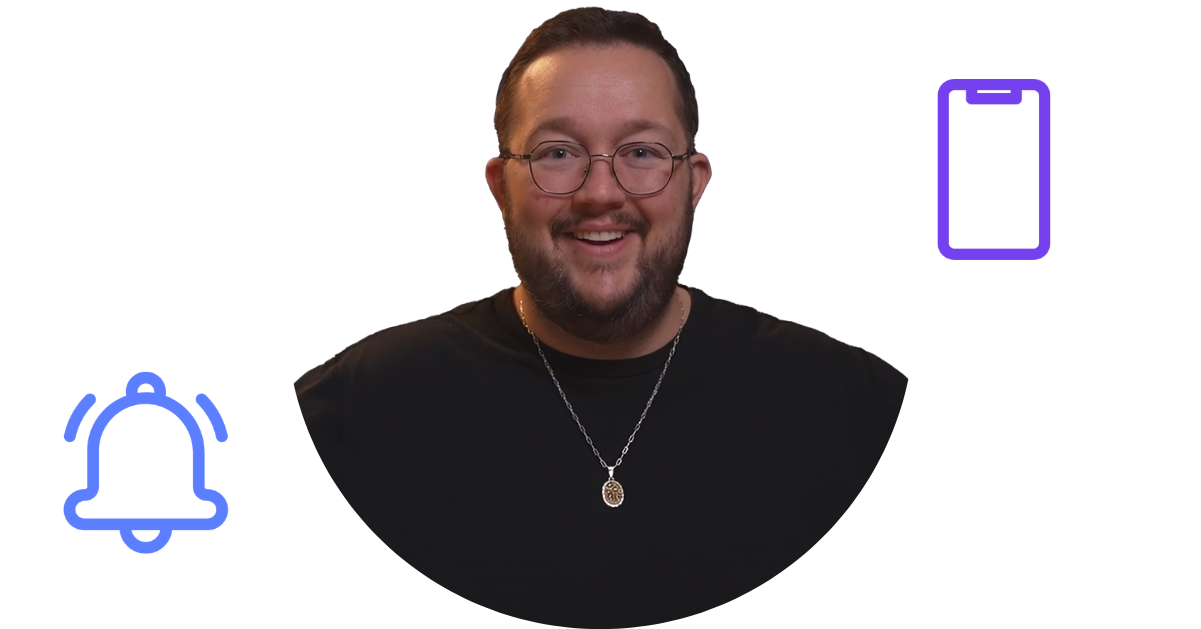Why Cold Calling is Far from Dead in 2025

It's never been easier to assume that tried-and-true methods like cold calling have lost their relevance.
But that couldn't be farther from the truth. It’s 2025, baby, and cold calling is still the backbone of building strong connections and getting deals done.
Just ask Kyle Vamvouris, who helps early-stage B2B startups scale with data-driven sales processes and high-performing teams.
“I think cold calling might be the last to die,” Kyle told PropertyRadar. “If you asked me about cold email, LinkedIn — even any social media outreach — I’d be more apt to say it’s dead than cold calling is. It’s still really effective, and it's been my most reliable channel for every team I’ve built.”

So much so that he’s developed over 80 sales teams for all of his clients at Vouris, the company he founded and leads as CEO.
With a proven track record of generating over $100 million in revenue, Kyle is a key figure in the sales industry, known for transforming underperforming teams, optimizing sales processes, and coaching top talent to success.
So, what better way to learn than from the pro himself? He shared expert insights on the power of cold calling, covering everything from its lasting effectiveness to how it remains a key strategy for generating leads, even in a digital world.
If you’re on the brink of calling it quits on cold calling, looking to revamp your strategy, or just here for the ride, hear from the sales guru himself on why cold calling is far from dead:
Cold Calling Builds Real, Human Connection

Sadly, cold calling often gets dismissed as a relic of outdated sales strategies.
But let me tell you a story about someone who redefined what it means to engage with people directly — someone (other than Kyle, of course) who took cold calling to a whole new level.
“He was the best manager I ever worked with, a total character who taught me lessons I carry to this day,” Kyle began. “He’d walk backwards in the gym, accidentally bump into people, and turn every interaction into a memorable moment.”
But what really stuck? His relentless approach to closing deals.
“One day, a customer hesitated on paying an enrollment fee, saying she needed to go to the ATM for cash,” Kyle continued. “Instead of letting her walk out the door, he said, ‘Great, I need a walk too,’ and accompanied her.”
His philosophy? If they leave, they’re not coming back. It was a small, simple gesture, but it kept the conversation going.
"Once they’re willing to talk back and forth, you’ve moved the conversation forward,” Kyle added. “Now it’s about seeing if you even have something they need.”
That’s the essence of cold calling — it’s about being present, proactive, and willing to engage in ways that make you memorable. But it doesn’t have to be pushy or exploitative.
In fact, the best sales strategies respect people’s autonomy while helping them make decisions that benefit them.
Cold calling, when done right, builds trust and opens doors. It’s not about pressure tactics or psychological tricks.
It’s about being human, having conversations, and understanding that every interaction is an opportunity to help someone solve a problem. Whether it’s a transactional sale that closes in days or a longer six-month pipeline, cold outreach remains a critical part of the equation.
You're Able to Have Genuine Conversation Over The Phone

At its core, sales is about conversations. While conferences and face-to-face meetings might be the gold standard, the next best thing is a genuine back-and-forth dialogue.
Cold calling offers this opportunity in ways other channels — like email or social media — simply cannot.
Through a phone conversation, you can position yourself as a solution to a prospect’s problems, tailoring your approach based on how they articulate their challenges. This level of nuance and adaptability is unmatched by the impersonal nature of other outbound outreach.
A successful cold call isn’t about pushing for an immediate sale — it’s about establishing curiosity and connection.
"Framing it as, ‘Let’s see if I can even help you,’ creates a more genuine and engaging tone,” Kyle said.
Think of it as the start of a relationship. The goal is to guide the prospect from initial resistance ("I don’t want to talk to you") to genuine interest.
This process usually involves the following.
Breaking Down Barriers

The first few seconds of a cold call are critical, as they set the tone for the entire conversation. Most people instinctively dismiss unknown callers, so your goal is to break through that initial resistance and establish a sense of trust.
Start by acknowledging the natural skepticism that comes with a surprise call. For example, saying something like, "Hi, I know this call is unexpected, but I’ll be brief and to the point," can immediately lower defenses.
Follow this by demonstrating that your outreach is intentional and relevant. A personalized hook — such as referencing a recent milestone or industry challenge — shows you’ve done your research and positions you as someone who adds value.
Once you’ve captured their attention, focus on building rapport by expressing genuine curiosity or sharing relatable insights.
Pivot quickly to why your call matters, stating a clear and concise value proposition early on. For example, you might say, "I’m reaching out because I’ve helped teams like yours save hours each week by addressing [specific challenge]."
Finally, give the prospect a sense of control with a permission-based question, such as, "Would you be open to a quick 30-second overview to see if this is relevant to you?"
This approach not only respects their time but also invites them into a collaborative conversation. By blending empathy, relevance, and a clear purpose, you can effectively break down barriers and set the stage for a productive dialogue.
Creating Curiosity

As Kyle puts it, “Cold calling isn’t about closing a sale on the first call. It’s about building curiosity and trust to justify a second conversation.”
Why? Because building curiosity keeps the conversation engaging and encourages the prospect to stay on the line.
So start by positioning your offering as a tailored solution to their unique challenges. Avoid launching into a lengthy pitch. Instead, focus on asking thoughtful, open-ended questions that invite them to share their perspective.
For example, you might say, "I noticed [specific detail about their business or industry], and I’m curious — how are you currently addressing [common pain point]?"
As they respond, actively listen and build on what they share. Use their answers to highlight the value of your solution in a way that directly addresses their concerns.
For instance, if they mention struggles with efficiency, you could say, "That’s exactly why I reached out. Our platform has helped companies like yours reduce [specific inefficiency] by [percentage or time]."
By aligning your solution with their specific situation, you foster curiosity about how you can help. Keep the tone conversational, and aim to spark intrigue rather than overwhelm with information.
End the interaction with a subtle hook, such as, "Would it make sense to explore this further? I’d be happy to walk you through how others in your space have tackled similar challenges."
This keeps the door open for future engagement while positioning your offering as a resource worth considering.
Building Toward the Next Step

"Cold calling lets you position yourself as a solution to the problems they’re actually having and how they articulate those problems,” Kyle told PropertyRadar.
Every cold call should have a clear purpose because the main goal is to move the prospect closer to meaningful engagement — whether that’s scheduling a follow-up meeting, exploring their needs further, or providing additional value.
To build toward that next step, you need to leave the prospect with a compelling reason to continue the conversation. Start by recapping the key points of your discussion to show you’ve been listening and understand their challenges.
For example, you could say, "From what you’ve shared, it sounds like [specific pain point] is a priority for you right now. I’d love to explore further how we’ve helped others in your situation achieve [specific benefit]."
Then, make a clear, actionable ask. Avoid vague statements like "Let’s touch base sometime." Instead, propose a specific next step, such as, "Would next Tuesday at 10 a.m. work for a quick 15-minute call to explore this further?" Offering a concrete time demonstrates that you value their schedule while keeping the momentum of the conversation.
Be prepared for objections and have responses ready to address them. For instance, if they express hesitation, you could counter with a low-commitment alternative: "I understand timing can be tight. How about I send over a quick case study or a one-pager you can review at your convenience?"
Finally, express gratitude for their time and reiterate your enthusiasm for continuing the discussion. A strong, positive close, such as, "Thanks for sharing your insights today — I’m excited about the potential to collaborate and make a real impact," can leave a lasting impression and increase the likelihood of a follow-up.
Cold Calling Prioritizes Fundamentals Over Flashiness

Many sales tools promise big returns, but they can end up making things more complicated and less efficient. Think automated email sequences, complex CRM systems, or high-tech dialers that require a lot of setup but don't necessarily lead to better results.
Cold calling, however, is simple and effective. It’s a basic skill that has worked for all industries for years.
As Kyle puts it, "The fundamentals, like doing cold calling really well, are absolutely critical. It’s a prerequisite before you start buying any tools or fancy technologies.”
It’s not about picking up the phone and blabbing on and on from your curated script — it’s about connecting with your prospect on a deeper level.
So instead of reading a script, try refining your pitch so it resonates with the person on the other end.
This means understanding what they care about, what challenges they’re facing, and how your solution can genuinely help them.
As mentioned in the previous section, building rapport is equally as important. People buy from people they trust, so focus on establishing a relationship, not just a transaction.
Ask questions that get them talking, listen actively to their responses, and tailor your message based on what they share. By taking the time to understand your prospect, you’re showing that you value them as individuals, not just potential customers.
“It’s critical to listen for interest signals — when they ask how you can help, that’s your opportunity to take things further,” Kyle said.
But what about the pacing? Rushing to close the deal on a cold call is a common mistake. Kyle points out that, particularly in B2C (business-to-consumer), the aim isn’t necessarily to sell but to spark enough interest to warrant the next conversation.
For instance, if you’re cold calling about selling a home, it’s unrealistic to expect a decision on the spot. Instead, focus on uncovering whether it’s even worth exploring the opportunity further. Think of it as laying the foundation for a relationship rather than trying to close the deal in one go.
Authenticity vs. Scripting

Building on the points above, let’s take the idea of authenticity versus scripting to the next level.
When it comes to crafting the actual conversation, finding the right balance is crucial. If you rely too heavily on a fully scripted call, you might end up sounding robotic, which can turn prospects off.
On the flip side, improvising the entire conversation without a plan can lead to rambling or missing key points, leaving your prospect confused or uninterested.
Striking that middle ground is what sets great sales calls apart.
For simpler, transactional sales — like offering a discount or explaining a straightforward product — memorizing a well-crafted script can be effective.
The key here is to rehearse it enough that you deliver it naturally, with the right tone and energy, rather than sounding like you’re reciting a monologue. A polished delivery builds confidence and keeps the conversation on track.
However, for more complex interactions — such as pitching a high-value product or addressing a prospect’s unique pain points — a rigid script can backfire. Instead, use a loose framework or bullet points.
These provide a roadmap to guide the conversation, ensuring you hit all the important points while leaving room to adapt based on the prospect’s responses.
For example, you might prepare a list of key benefits, common objections, and thoughtful questions to ask, allowing you to pivot naturally as the conversation flows.
No matter the approach, authenticity is non-negotiable. People can tell when you’re just reading a script versus genuinely engaging with them.
Show genuine interest in their needs, listen carefully, and respond thoughtfully. Prospects are far more likely to open up and stay engaged when they feel they’re talking to a real person who cares, not a sales machine.
Remember, the goal isn’t just to deliver information — it’s to build a connection and inspire trust.
Track the Right Metrics

Kyle’s success isn’t just a fluke — it’s rooted in data-driven strategies. A strong advocate for tracking the right metrics, he emphasizes that understanding the numbers is key to refining and improving cold-calling performance.
At the top of the funnel, metrics like call volume, connection rates, and meetings booked give a clear picture of your team’s efficiency and the script’s impact.
For instance, if 100 calls lead to 10 connections but only one meeting, you’ve identified a gap. Is the issue with the pitch's delivery, or does the request for a meeting need adjustment?
By breaking down the numbers, you can focus your efforts where they’ll make the biggest difference.
Kyle also highlights the value of granular tracking to uncover hidden bottlenecks. For example, keeping tabs on how often intros are delivered or how many times meetings are requested can reveal where the process is stalling. These details might seem minor, but they often hold the key to significant improvements.
He takes it a step further by analyzing each part of a call to pinpoint areas for growth. As Kyle explains, “If your connect rate is great but you’re not booking meetings, the problem isn’t your outreach — it’s your messaging.”
This level of scrutiny ensures every aspect of the cold-calling process is optimized, from the first hello to the final ask, creating a more effective and consistent approach to engaging prospects.
You'll Reach the Right People, at the Right Time

The true magic of cold calling isn’t just in making calls — it’s in knowing who you’re calling and why. The smaller and more specific your audience, the better your results.
This isn’t just about throwing darts at a board (although that’s always fun) — it’s about narrowing the scope so your message resonates.
For example, starting a call with, “Hi, I noticed you own a home in [neighborhood], and I wanted to share something relevant to homeowners in your area,” instantly provides context. It shifts the conversation from generic to specific, creating a sense of intentionality and relevance.
But there’s a balance: while targeting helps you sound informed, it’s crucial to avoid making prospects feel like they’re under a microscope. As Kyle put it, “You want to be super targeted, but never make the person feel targeted."
If you’re investing in leads, consistency and strategy are non-negotiable. Start by defining your ideal client profile — who they are, what they need, and why they’d want to engage with you.
Then, use tools like PropertyRadar to refine your targeting and avoid wasting your budget on low-quality leads that don’t align with your goals.
These tools allow you to filter prospects by factors like location, property details, or ownership duration, ensuring your outreach is focused on those most likely to convert.
Once you’ve identified the right leads, it’s critical to have a system for consistent follow-up. A single call is rarely enough to close a deal.
Create a schedule to reconnect with prospects, offering value each time you reach out. Whether it’s sharing relevant market insights, answering questions, or addressing objections, consistency builds trust and keeps you top of mind.
If You're Cold Calling, It's Easier To Lead With Empathy

Cold calls flop all the time because they feel like they’re coming from a robot, not a real person.
Think about it: when was the last time you stayed on the line for someone reading off a bland script that could’ve been meant for anyone? Exactly.
The fix? Show some empathy and start with what you know about the person you’re calling.
It’s not hard. Mention where they’re located or something relevant to their situation. Say something like, “Hey, I noticed you’re in [neighborhood], and I’ve been helping homeowners there with [specific issue].
That one detail changes everything. It says, “I’m calling you for a reason,” instead of, “I’m just checking names off a list.”
When you get this right, the call flows so much smoother. You’re not wasting time explaining yourself or awkwardly answering “What’s this about?” because they already know.
You’ve made it clear from the start that this is about them — not you just pitching for the sake of it.
Most importantly, don’t overdo it. Getting too personal can make people uncomfortable, like you’re snooping on their life.
"Even though you’re making a cold call, you want the interaction to feel warm, intentional, and personal to them,” Kyle said.
At the end of the day, cold calling works best when it doesn’t feel “cold” at all. Show some effort, be human, and make the person on the other end feel like you’re calling them with a purpose — not just dialing for the sake of it.
And if you need a little help along the way, we’ve got your back. You can conduct a comprehensive audit of your outbound marketing efforts with "The Complete Guide to the Good Neighbor Marketing Pledge and Checklist." It’s filled with valuable insights on how to be the thoughtful, empathetic person we all know you can be.
So, if you’re ready to crush the phone game (because by now, you should know that cold calling is far from dead), we’ll leave you with some words of wisdom:
“The best thing you can possibly do is have a conversation with a potential customer,” Kyle told PropertyRadar. “Nothing else allows you to position yourself as a solution to their problems in quite the same way.”
Get a free PropertyRadar trial and start using phone marketing to reach out to your favorite lists in minutes.



